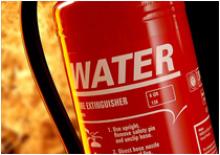Portable Extinguishers – Getting To Grips With The Real Issues
Portable Extinguishers - Getting To Grips With The Real Issues
Recent changes in legislation have brought about a greater appreciation of the need for the implementation of effective ‘first aid’ firefighting measures – in particular, the use of portable extinguishers. Following the enactment of the Fire and Rescue Act, brigades may not respond to all emergency calls within the same timescale, and they may also decide not to enter a burning building to fight the blaze unless they believe the building is occupied. So, portable extinguishers may be all that stops a minor outbreak escalating into a property or life-threatening fire.
Certainly, the contribution made by portable extinguishers is undeniable. According to the Fire Extinguishing Trades Association – now merged with the BFPSA to form the Fire Industry Association – portables save the British economy around ┬ú500 million every year and extinguish around 66,000 fires. This compares with figures that show that the fire and rescue service in the UK attended 88,400 fires in buildings in the UK in 2006.
So, the recent case where the managing agent of a block of flats was advised to remove portable extinguishers from common areas ‘as a way of improving fire safety’ could, if widely adopted, place a crushing burden on an already strained fire service. The consequences could be catastrophic.
Surely, we should be focusing on the safe use of portable extinguishers. Under the Fire Safety Order, the ‘responsible person’ is charged with making ‘reasonable’ decisions about every aspect of fire safety. This, obviously, includes the selection of portable extinguishers, and the need to ensure they are fit-for-purpose and form an effective and reliable part of the building’s fire safety regime.
Selecting the right extinguisher for a particular fire safety challenge is of prime importance. Water and foam portables are particularly suited to Class A fires involving flammable solid materials such as wood, paper and cloth. Along with CO2, foam is also the correct choice for Class B fires involving flammable liquids or liquefiable solids. Powder portables are ideal for Class A, B and C fires that involve flammable gases.
However, there are a growing number of applications where this ‘broad-brush’ approach to portables selection is not wholly appropriate and special application portables are the right choice. Examples of these include: Class D portables for metal fires, for which new powder extinguishers have now been developed; antimagnetic CO2 portables for applications such as hospitals and clinics, where sensitive electrical equipment may be affected by magnetising metals; and special water portables designed for sawdust fires. Other recent TOTAL innovations include new powder portable extinguishers for coal dust fires; a special wet chemical agent for Class F portables for kitchens, where cooking oils and fats have the potential to flare up in an instant; and a specially-formulated foam agent for polar liquid fires that are a hazard in the cosmetics, pharmaceutical, distilling and adhesives industries.
Further details on TOTAL portable extinguishers are available from Express Fire on + (0) 161 688 5050 or from Tyco Safety Fire Suppression & Building Products on +44(0) 161 875 0400 or via email at tspmarketing.emea@tycoint.com

